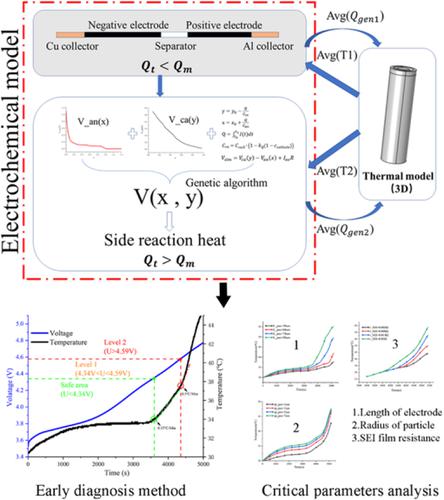当前位置:
X-MOL 学术
›
Int. J. Energy Res.
›
论文详情
Our official English website, www.x-mol.net, welcomes your
feedback! (Note: you will need to create a separate account there.)
Thermal safety study of Li‐ion batteries under limited overcharge abuse based on coupled electrochemical‐thermal model
International Journal of Energy Research ( IF 4.3 ) Pub Date : 2020-01-23 , DOI: 10.1002/er.5125 Ganghui Zeng 1 , Zhonghao Bai 1 , Peifeng Huang 1 , Qingsong Wang 2
International Journal of Energy Research ( IF 4.3 ) Pub Date : 2020-01-23 , DOI: 10.1002/er.5125 Ganghui Zeng 1 , Zhonghao Bai 1 , Peifeng Huang 1 , Qingsong Wang 2
Affiliation

|
Many fire accidents of electric vehicles were reported that happened during the charging process. In order to investigate the reasons that lead to this problem, this paper studies the thermal safety of Li‐ion batteries under limited overcharge abuse. A 3D electrochemical‐thermal coupled model is developed for modeling thermal and electrochemical characteristics from normal charge to early overcharge state. This model is validated by experiment at charge rates of 0.5C, 1C, and 2C. The simulation results indicate that irreversible heat contributes most to temperature rise during the normal charge process, but the heat induced by Mn dissolution and Li deposition gradually dominates heat generation in the early overcharge period. Based on this, a threshold selection method for multistage warning of batteries overcharge is proposed. Among them, level 1 should be considered as a critical stage during the early overcharge process due to the deposited lithium starts to react with electrolyte at the end of level 1, where temperature rate increases to 0.5°C min−1 for 1C charge. While the thresholds of levels depend on charge rate and composition of battery. Furthermore, several critical parameters are analyzed to figure out their effects on thermal safety. It is found that the temperature at the end of overcharge is significantly influenced by the change of positive electrode thickness and solid electrolyte interface (SEI) film resistance. The final temperature increases by 17.5°C and 7.9°C, respectively, with positive electrode thickness ranging from 50 to 80 μm and SEI film resistance increasing from 0.002 to 0.03 Ω.
中文翻译:

基于耦合电化学-热模型的有限过充电滥用下锂离子电池的热安全性研究
据报道,在充电过程中发生了许多电动汽车起火事故。为了调查导致此问题的原因,本文研究了在过度充电受限的情况下锂离子电池的热安全性。开发了3D电化学-热耦合模型,用于对从正常充电到早期过充电状态的热和电化学特性进行建模。通过在0.5C,1C和2C的充电速率下进行实验验证了该模型。模拟结果表明,在正常充电过程中,不可逆热是温度升高的主要因素,但在过充早期,Mn溶解和Li沉积引起的热量逐渐占主导地位。基于此,提出了一种用于电池过充多阶段警告的阈值选择方法。其中,-1表示1C充电。而级别的阈值取决于充电速率和电池组成。此外,分析了几个关键参数,以找出它们对热安全性的影响。发现过充电结束时的温度受正极厚度和固体电解质界面(SEI)膜电阻的变化影响很大。最终温度分别升高了17.5°C和7.9°C,正极厚度为50至80μm,SEI膜电阻从0.002至0.03Ω。
更新日期:2020-01-23
中文翻译:

基于耦合电化学-热模型的有限过充电滥用下锂离子电池的热安全性研究
据报道,在充电过程中发生了许多电动汽车起火事故。为了调查导致此问题的原因,本文研究了在过度充电受限的情况下锂离子电池的热安全性。开发了3D电化学-热耦合模型,用于对从正常充电到早期过充电状态的热和电化学特性进行建模。通过在0.5C,1C和2C的充电速率下进行实验验证了该模型。模拟结果表明,在正常充电过程中,不可逆热是温度升高的主要因素,但在过充早期,Mn溶解和Li沉积引起的热量逐渐占主导地位。基于此,提出了一种用于电池过充多阶段警告的阈值选择方法。其中,-1表示1C充电。而级别的阈值取决于充电速率和电池组成。此外,分析了几个关键参数,以找出它们对热安全性的影响。发现过充电结束时的温度受正极厚度和固体电解质界面(SEI)膜电阻的变化影响很大。最终温度分别升高了17.5°C和7.9°C,正极厚度为50至80μm,SEI膜电阻从0.002至0.03Ω。











































 京公网安备 11010802027423号
京公网安备 11010802027423号